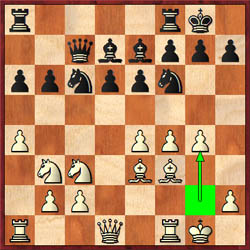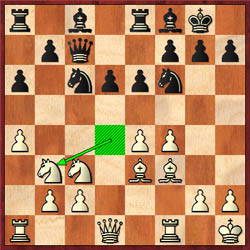 |
 |
 |
 |
 |
 |
 |
 |
 |
|
|
|
|
|
|
|
|
|
|
 |
|
|
|
|

|
|
|
|
|
|
|
|
|
Round #11 Pairings
Adams (England) - Topolov (Bulgaria)
Anand (India) - Kasimjanov (Uzbekistan)
Polgar (Hungary) - Leko (Hungary)
Svidler (Russia) - Morozevich (Russia)
***
Round #11 Results
Adams-Topalov, ½-½. As anticipated, this was a hard-fought battle as Adams pressed for the attack attempting to get his first victory of the tournament. Topalov trotted out the Schevenigen, but did not have the same opening disaster as did Polgar against Kasimjanov in the previous round. If one looks at the two games after move 13, important differences exist. In the Kasimjanov-Polgar game, black had already played …Bd7 and …b6 whereas Topalov had played …Re8 and …Bf8 instead. These are major differences since 13.g4 seen in Kasimjanov-Polgar would not have the same effect in this game.
|
|
|
|
|
|
|
|
|

|
|

|
|
|
|
|
|
|
|
|
In Kasimjanov-Polgar, white plays 13.g4 and black already has problems.
|
|
|
|
|
|
|
|
|
|
In Adams-Topalov, black's pieces are well-placed to meet a possible g4.
|
|
|
|
|
|
|
|
|
|
|
|
|
Later on, Adams went for the juglar and after 21.Ng5 forced Topalov to yield the dark squares around his king with 22…Bxg5 22.Bxg5. Adams continued with his onslaught with 26.Nh5 with tremendous complications if Topalov played 26…gxh5. Topalov did not go into that line and played for a counterattack, but missed the intermezzo 29.Nd6+! White had a clear advantage, but then Adams shocked everyone with 36.Rxe6?! going for a mating attack. After sacrificing the exchange he had won earlier, the game meandered into a series of checks by Adams, but he could not amount to more than that. Draw. (game, ChessBase video)
Anand-Kasimjanov, 1-0. This game was a complete opening disaster for black. In a tournament of Sicilians, the dynamic defense was tested yet again. In the press conference, Grigory Kaidanov asked Anand how far into home preparation did he play. Anand answered that much of it were found over the board. This 6.f3 Najdorf featured a novelty in 13.Na5! Kasimjanov mentioned that he had seen an earlier game with this idea, but did not think much of it (that game was drawn). Kasimjanov's next move quickly determined his fate.
After 13…Rc8? Anand's 14.Bb6! Kasimjanov realized what was happening and in the press conference stated that he wanted to take 13…Rc8 back and play 13…Rb8! instead. Kasimjanov 13th move made absolutely no sense other than guarding the c4-pawn and Anand made him pay. The other move that drew attention was Anand's 15.g3!? The idea was to play f4 and e5 taking advantage of black's misplaced queen. Black finally got to play …Rb8, but missed a chance after 19.h3. Instead of 19…Nf6, commentators suggested 19…Nh2! with favorable exchanges. After this the game became a rout. Anand won the d6-pawn and finished off the game with 26.Nd5! Bxd5 27. Rxd5 Bb8 28. Rhd1 c3 29. Rd7. Kasimjanov never got a chance to castle. Nice game by Anand! (game, ChessBase videos - Anand, Kasimjanov)
|
|
|
|
|
|
|
|
|
|
|
|
|
Polgar-Leko, ½-½. This was a game full of some nice tricks, but ended peacefully. It amounting nothing more than two players repeating theory and showing off a few tactics. The idea behind Polgar's 8.Qb3 Bxf3 9.gxf3 is to win the bishop pair in exchange for a wrecked kingside. In these types of positions where black is behind in development, speed and fast attacking routes are more important. If black tries to hold onto material, then white gets an overwhelming attack. After 10.Qxb7 Nxd4, the game quickly fizzled after 11.Bb5+ Nxb5 12.Qc6+ Ke7 13. Qxb5 Qd7 14. Nxd5+ Qxd5 15. Bg5+ f6 16. Qxd5 exd5. The game could have been stopped here, but they played on ten more moves before agreeing to a draw. These exact moves have occurred before. (game)
Svidler- Morozevich, 1-0. This would become one of the longest games of the tournament as the two Russians battled for six hours. 'Peter the Great' would defeat 'Alexander the Great' as Svidler would gain ½-point on Topalov with three rounds remaining. White developed a slight advantage out of the opening and concentrated on pawn weaknesses in black's camp. As Svidler arranged a cluster of pieces in the center of the board, Morozevich sought counterplay by tactical means. Condemned to losing his c6-pawn, he played 31…Nb6. Svidler played the simple 32.Nxf7 and continued to bear down on black's weaknesses.
A pair of bishops were are that remained after 58.Nf5+! Nxf5 59.gxf5. White had won another pawn, but black was racing to the white kingside to fill his hunger for defenseless pawns. Interestingly enough, white held every pawn and even allowed black to create a passed pawn. A last attempt at deflection from 67…Bb5 brought no results and the game featured a bit of humour as Morozevich played 69…Bg6 which was met by 70.Bxg6. Great performance by Svidler. (game)
|
|
|
|
|
|
|
|
.jpg)
|
|
|
|
|
|
|
|
|
|
Judit Polgar has had it rough, but there is no question that she belongs among the elite players. (Photo courtesy of WCC official site)
|
|
|
|
|
|
|
|
|
|
|
|
|
|
|
Standings:
1st Topalov, 8½-2½
2nd Svidler, 7-4
3rd Anand, 6½-4½
4th Morozevich, 5½-5½
5th Leko, 5-6
6th Kasimjanov, 4½-6½
7th Adams, 4-7
8th Polgar, 3-8
|
|
|
|
|
|
|
|
|

|
|
|
|
|
|
|
|
|
 |
|



.jpg)
